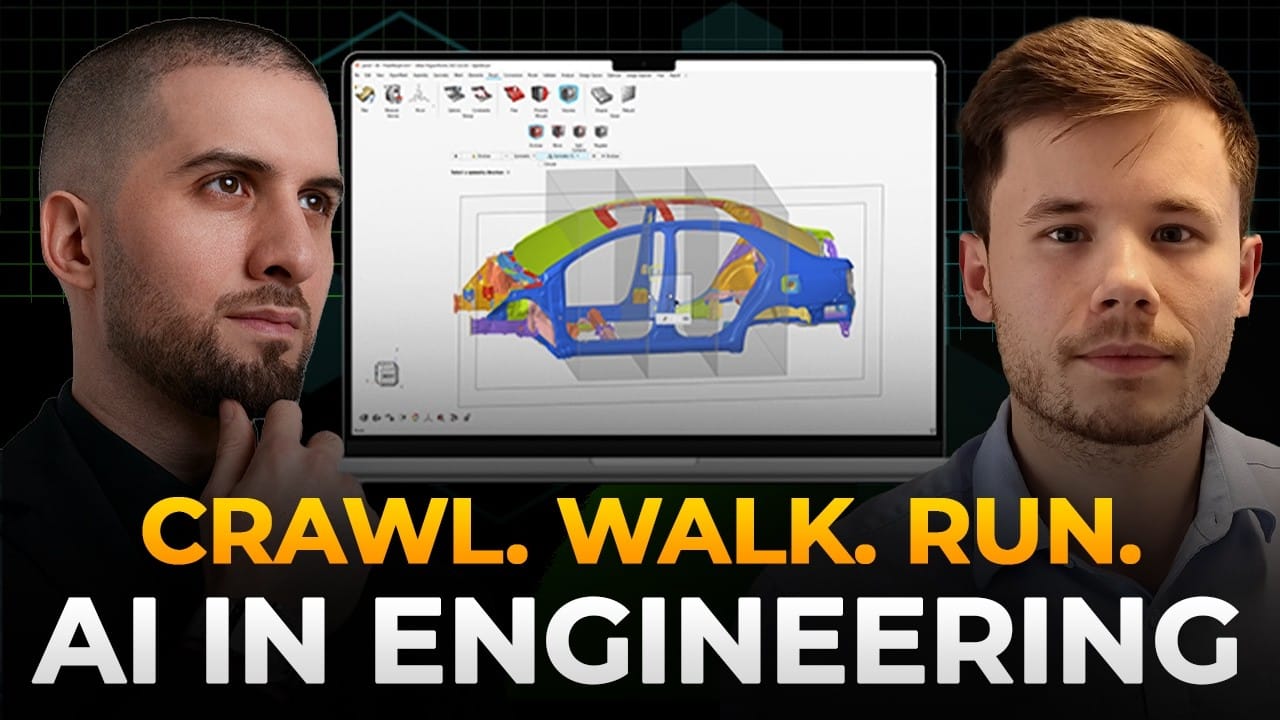Introduction
Using AI in engineering isn't a one-and-done thing; it's an ongoing journey. This journey, while exciting and rewarding, requires a clear strategy, careful planning, and effective implementation. Roland Jones, a solutions specialist at Altair, recently appeared on the Engineered-Mind Podcast to discuss this complex path toward AI integration.
In this blog, we explore the key takeaways from Roland, including the phases of AI adoption, the importance of data preparation, the fusion of physics-based and data-driven approaches, practical use cases like predictive maintenance, and how Altair’s tools support scalable AI solutions in engineering.
Let’s get started!
The AI Adoption Journey: An Overview
AI adoption can be understood as a phased approach, beginning with foundational descriptive analytics, advancing through predictive analytics, and ultimately culminating in prescriptive analytics. Descriptive analytics involves leveraging historical data to understand past events clearly. Predictive analytics then moves a step further, forecasting future outcomes based on historical trends. Prescriptive analytics represent the pinnacle of AI capability, offering real-time recommendations and optimal decisions, thus transforming data into actionable insights.
The Importance of Data Preparation
A critical component of any successful AI deployment is robust data preparation. The adage "garbage in, garbage out" remains especially relevant in the context of artificial intelligence, where the quality of input data directly determines the accuracy and reliability of model predictions. In engineering contexts, this challenge is compounded by the complexity and diversity of data sources, ranging from structured datasets like spreadsheets and relational databases to semi-structured formats such as sensor logs and unstructured content, including scanned documents and technical reports.
Managing this data effectively requires a combination of cleaning, normalization, transformation, and sometimes even integration from disparate systems. These steps ensure the AI system receives well-prepared data capable of generating meaningful insights. Addressing this challenge at scale calls for platforms specifically designed for the engineering domain. Solutions like Altair® RapidMiner® provide an end-to-end environment for connecting, preparing, and analyzing data with minimal code. This empowers engineering teams to focus on solving real-world problems rather than wrestling with data quality issues, making streamlined data preparation a strategic advantage rather than a bottleneck.
Integrating Physics-Based and Data-Driven Approaches
An increasingly valuable strategy in modern engineering involves combining physics-based simulations with data-driven methodologies to create highly effective hybrid models. This integrated approach allows for a more complete understanding of complex systems by leveraging the strengths of both traditional engineering principles and modern machine learning techniques.
One of the most impactful applications of this fusion is the development of digital twins - virtual representations of physical assets that continuously evolve based on real-time data. These digital twins are capable of simulating behavior, predicting future performance, and diagnosing inefficiencies across a wide range of operational scenarios. For engineers, this means enhanced capabilities in predictive maintenance, process optimization, and decision-making under uncertainty.
Altair’s technology ecosystem supports this approach through platforms like Altair® RapidMiner® and Altair® IoT Studio™, which together enable the development, deployment, and scaling of digital twin solutions. By integrating real-time sensor data with simulation models, these tools provide a dynamic, interactive environment that drives efficiency and innovation across engineering workflows. As the demand for smarter, more adaptive systems continues to grow, the ability to bridge the gap between physical and digital domains becomes a key competitive advantage.
Differentiating AI, Machine Learning, and Data Science
Clearly distinguishing between artificial intelligence (AI), machine learning (ML), and data science is essential for effectively applying these technologies within engineering and industrial contexts. While these terms are often used interchangeably, they represent different, though interconnected, areas of technological advancement.
AI broadly refers to systems designed to mimic human decision-making processes. Machine learning, a core subset of AI, is specifically focused on enabling systems to learn from historical data and make accurate predictions or classifications without being explicitly programmed for every scenario. In contrast, data science is a broader discipline that integrates statistical methods, data engineering, and domain expertise to extract actionable insights from structured and unstructured datasets.
For engineers and technical decision-makers, understanding these distinctions is not just a matter of terminology - it has direct implications for selecting the right tools, designing effective workflows, and setting realistic project goals. Applying the appropriate technique or platform based on the problem at hand helps avoid misaligned expectations and ensures successful implementation. Educational resources and visual tools available through platforms like Altair® RapidMiner® can help teams navigate this landscape, bridging the gap between theoretical understanding and practical application. For hands-on training and guided learning paths, engineers can also explore the RapidMiner Academy to deepen their skills and apply concepts directly to real-world problems.
Practical Use Cases and ROI
A range of practical use cases demonstrates how AI can significantly enhance engineering performance and decision-making. One prominent application is predictive maintenance, which enables organizations to anticipate equipment failures before they occur. By continuously monitoring sensor data and identifying early signs of wear or malfunction, AI-powered systems help reduce unplanned downtime, extend asset lifespans, and optimize maintenance schedules. This proactive approach yields measurable cost savings and enhanced operational efficiency.
Another impactful use case involves automating report consolidation, particularly in areas such as warranty tracking and field service analysis. Engineering teams frequently encounter large volumes of scattered and unstructured data, including service logs, inspection notes, customer feedback, and incident reports. AI can synthesize this data into cohesive insights, accelerating root-cause analysis and enabling faster, more informed design or quality assurance decisions.
These examples reflect just a few ways AI is being leveraged to deliver tangible value across engineering workflows. To explore more real-world applications and implementation strategies, visit the Altair Blog.
AI: Augmentation, Not Replacement
Discussing the future, Roland addressed concerns regarding AI potentially replacing engineering jobs. He argued convincingly that AI is best viewed as an augmentation tool rather than a replacement. Experts, Roland emphasized, will remain indispensable as they provide essential guidance and oversight in the increasingly democratized AI environment.
Conclusion
In the podcast, Roland concluded the discussion with valuable advice: organizations starting their AI journey should choose clearly defined, measurable use cases. Education, continuous learning, and experimentation remain vital for successful AI integration. Engineers and businesses alike should embrace AI not as a threat but as a powerful ally, delivering unprecedented efficiency and precision.

